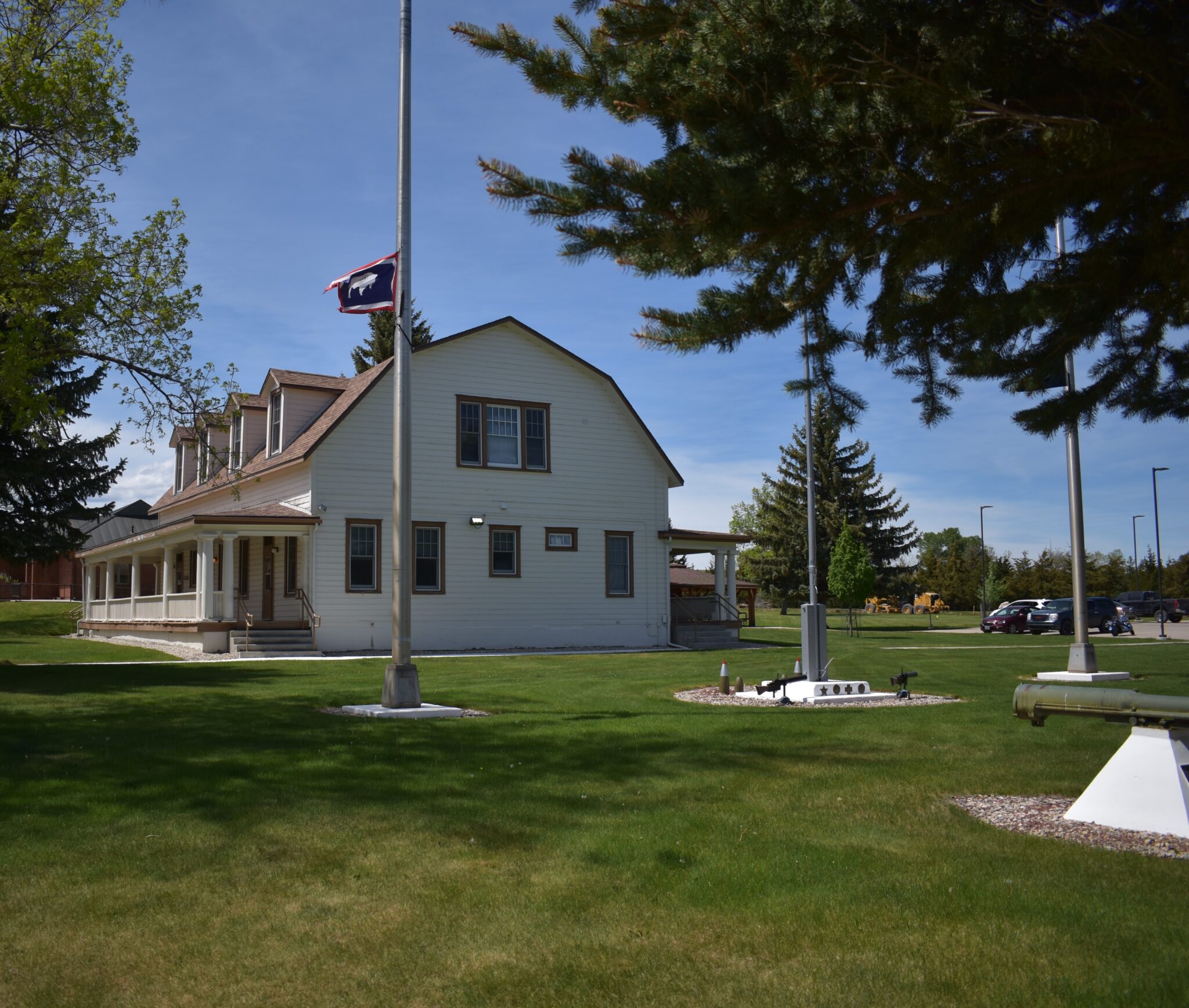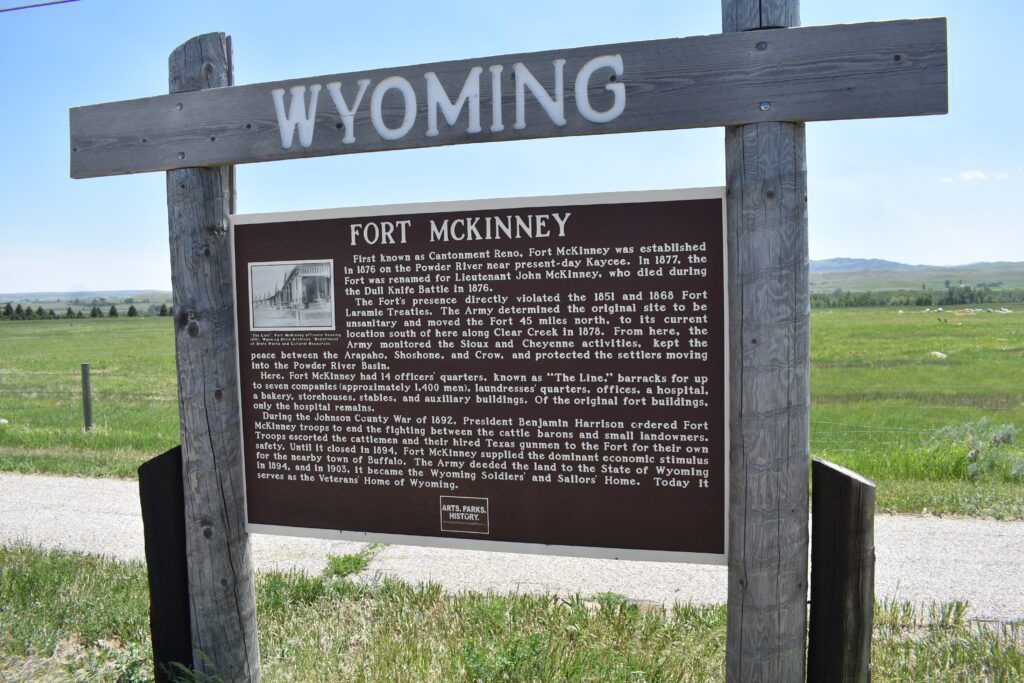News
History: The McKinney Strip Contest
Published
6 months agoon
By
cvannoy
When Wyoming was a very new state, it was granted statehood on July 10 of 1890, there was a fight over who owned a strip of land, known as the McKinney Strip, which both the city of Buffalo and the Department of the Interior claimed as their own. Buffalo wanted it to expand the town, and Dept. of the Interior wanted it for its minerals. This is the story of the McKinney Strip contest.
The Big Horn Sentinel (Buffalo), February 9, 1889 – Something over a year ago a petition was circulated in Buffalo petitioning for a strip off from the Fort McKinney military reservation to be used for town, park and cemetery purposes. Notification has been received by the authorities at Fort McKinney that the request has been granted, and a strip of land a quarter of a mile wide and extending across the reservation on the east has been vacated and certified to the general land office, which will proceed to dispose of the land as provided for under the act of congress of July 5, 1881.
This is an important acquisition for Buffalo and will tend to give the city a vigorous growth as it heretofore been contained to a narrow track hemmed in on the west by the reservation and on the east by a range of bluffs.
War Dep’t Washington, Jan 16, 1889 – By authority of the president of the United States and under Ihe provisions of the first section of the act of Congress approved July 5, 1884, entitled “An act to provide for the disposal of abandoned and useless military reservations.” So much of the military reservation of Fort McKinney, Wyoming, set by aside of July 2, 1879 is embraced within the following described boundary, to wit: Commencing at the southeast corner of said reservation and running; thence westerly and along the south boundary of said reservation a distance of one quarter of a mile; running thence due north for a distance of four miles to the north boundary of said reservation; thence easterly and along north boundary. said reservation for a distance of a quarter of a mile to the northeast corner Thence southerly and along the east boundary for a distance of four miles to the point of the beginning, is hereby transferred and turned over to the secretary of the Interior for disposition as provided in the subsequent sections of the aforesaid act, the same being no longer required for military purposes. Wm. C. Endroutt, Secretary of War.
The following story about the contest appeared in The Buffalo Bulletin, December 4, 1890 – THE CITY WINS! The McKinney Strip Contest Settled at Last. Below will be found the decision of the Register and Receiver of the Buffalo land office in the contest case of the Fort McKinney reservation Strip. It was handed down on Friday morning, and The Bulletin, appreciating the vast importance of this decision to the City of Buffalo, issues an extra and gives the full text of the document, which will be found one of the most lucid and important land case findings over given in Wyoming.
United States Land Office, Buffalo, Wyoming. Ephraim H. Smock, Richard J. Daley, Fernando C. Eldred, George T. Beck, Contestant, versus Hon. Henry H. Elliott, Mayor of the City of Buffalo, Wyoming, Claimants. Involving the north half of the strip cut off from the military reservation of Fort McKinney, Wyoming, by executive order of January 10, 1889, and embodied and embraced in the act of congress, entitled, “To authorize the purchase of certain public lands by the city of Buffalo Wyoming, and for other purposes,” approved June 17, 1890.
Register’s and Received opinion and findings – The act of congress above referred to and under which this case arises provides: “That the City of Buffalo, Wyoming, is hereby authorized to enter under the townsite laws for townsite, cemetery and park purposes, the north half of the strip of land released from the Fort McKinney military reservation by executive order, dated January 10th, 1889, * * * Provided that if it shall be proven to the satisfaction of the Secretary of the Interior that any of the lands so authorized to be purchased by said city are valuable for coal or minerals, such portion shall be excluded from such townsite entry.”

The record in the case discloses, that on the 28th day of July, 1800, the above-named contestants as an association of persons presented to this office their application to enter the said tract of land in contest under the provisions of the Revised Statutes of the United States relating to the sale of coal lands of the United States. In this application it is alleged that the land applied to be entered contains large deposits of coal and is chiefly valuable therefor, An appearance from the rejection indulged on the application it was refused and denied for two reasons: first because the land was unsurveyed; second, because the City of Buffalo, through Its Mayor, had, on the 10th day of October, 1889, applied to enter said land under the townsite laws, which application was pending before the Hon. Secretary of the Interior on appeal from the rejection of this office. On the same day the contestants filed notice of their intention to appeal from the decision of this office, rejecting their application.
All of the witnesses for the city are of one opinion that this tract of land is not valuable for its deposits of coal. It appears to us that it has been clearly proven by a preponderance of evidence that this tract of land cannot be classed as coal land and that it in more valuable for agricultural purposes or for those named m the grant, viz, townsite purposes, than for its deposits of coal. We are therefore of the opinion that the city of Buffalo has the right of entry under the townsite laws as named in the grant. And we are also clearly of the opinion that under no circumstances would these coal claimants have the right of entry even should it be proven that he lands are valuable for coal.
For had it not been for the special act of June 17, 1890, those lands would have been disposed of under the law of July 5,1884, providing for the sale of abandoned military reservations. In that act the lands are to be sold at public auction under the directions of the Secretary of the Interior except “Whenever: any lands containing valuable; mineral deposits shall be vacated by the reduction or abandonment of any military reservation under the provisions of this act the same shall be disposed of exclusively under the mineral land laws of the United States.” Congress by the act of June 17, 1890, has clearly intimated that the mineral clause in the act of July 5, 1884, was not intended to include coal lands, for the first named act provides that all lands shall be excluded from the grant which shall be proven to be valuable for coal or minerals. If it was contemplated that coal was included m the words “valuable mineral deposits” in the act of July 5, 1884, then it was unnecessary to insert the word “coal” In the act of June 17, 1800, “under sections 2347 and 2352 of the Revised statutes of the United States coal lands are subject to preemption and entry precisely the same as agricultural lands except as to price and limit as to the amount which may be entered.”
Many people did not agree with closing the fort, as this story from The Enterprise, March 29, 1890

And this from the Newcastle Journal, January 23, 1891 – A Washington correspondent of the Cheyenne Sun says: There was some talk about the abandonment of Fort McKinney but since Wyoming’s admission as a state, this matter has resumed a very different aspect, senator Carey and Warren not only urged upon the war department the necessity of maintaining this post, but asked that in view of the recent Indian disturbances that it be largely reinforced in order that the settlers may have adequate protection from the various tribes that are located in that vicinity
The Boomerang, August 30, 1894

But, a few months later the fort was abandoned. The Cheyenne Daily Leader, November 2, 1894 – McKinney’s Abandonment. The text of the order by Gen. Brooks to abandon Fort McKinney reads: “Commanding Officer, Fort t Kinney, Wyo.— Fort McKinney to be discontinued Nov. 5 and the troops will leave the post on that date, the 8th infantry for Fort Russell and troop C, 9th cavalry for Fort Robinson by rail from Clearmont. The post quarter master and not to exceed twenty-five men from the 8th infantry, including the special men heretofore authorized, will be left at Fort McKinney to complete the shipment of property and close up affairs. The post surgeon, an acting hospital steward and one hospital private, the post ordinance, quartermaster and commissary sergeants will also remain at the post until further orders. The hospital steward and four privates of the hospital detachment will go to Fort Russell with the other troops. Lieut. Lafitte maybe left at the post to assist the post quartermaster.”
Later, it became the Wyoming Soldiers and Sailors Home, as it remains today. The old fort hospital building, although moved from its original location, is today the visitors’ house. The mule and cavalry stable also still remain.
Cheyenne Daily Leader, Volume 37, July 1, 1895

A contentious battle that increased the size of the City of Buffalo, the McKinney Strip Contest happened 133 years ago this month.


Nancy Jennings
December 17, 2023 at 7:44 am
Cynthia=always enjoy your articles. Have a merry Christmas!